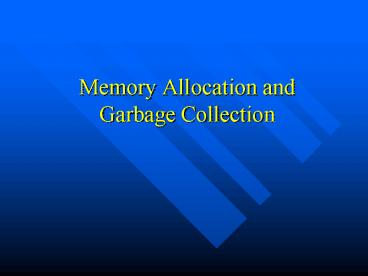Memory Allocation and Garbage Collection - PowerPoint PPT Presentation
1 / 12
Title:
Memory Allocation and Garbage Collection
Description:
A stack or queue is used to keep track of the objects that have been not been visited. ... While the stack is not empty pop one reference from the stack, scan it for ... – PowerPoint PPT presentation
Number of Views:79
Avg rating:3.0/5.0
Title: Memory Allocation and Garbage Collection
1
Memory Allocation andGarbage Collection
2
Why Dynamic Memory?
- We cannot know memory requirements in advance
when the program is written. - In early Fortran all memory had to be allocated
in advance. There was no dynamic memory - You can request memory dynamically using
malloc/new.
3
Types of Memory Management
- Dynamic memory needs to be recycled after it is
no longer in use or the system may run out of
memory. - There are two ways memory can be recycled
- Explicit Memory Management
- The program calls free/delete explicitly
- Automatic Memory Management
- The system determines what can be recycled using
Automatic Garbage Collection
4
Explicit Memory Management
- The program calls free/delete when object is no
longer in use. - Advantages
- It uses less memory. The program do not need to
wait to recycle memory. - Faster. No GC overhead and the memory allocated
is likely to be in cache.
5
Explicit Memory Management
- Disadvantages
- Error prone
- Memory leaks - Memory is never freed. It causes
system slow down or running out of memory swap
space. Bad 24/7 apps. - Premature Frees Memory is freed while still in
use. It causes the program to crash. - Double frees Free an object that is already
freed. - Free of Non-Heap objects Free an object that
was not allocated with malloc/free. - Memory leaks is less severe than the other three
but is still bad.
6
Implicit Memory Management
- Let the system determine what memory is no longer
in use and recycle it. - There are two basic approaches
- Reference Counting
- Tracing
7
Reference Counting
- In each object keep a counter that represents the
number of references pointing to the object. - When the reference counter reaches 0, it means
that there is no reference to this object so it
can be safely recycled.
8
Reference Counting
- Advantages
- Memory is recycled as soon as it is no longer in
use. - Disadvantages
- cycles will not be removed because the counter
never reaches 0. - Each pointer assignment will need an
increment/decrement operation in the counters. - It is used by Perl, Phyton and some times in Java
with auxiliar GC to collect cycles.
1
2
1
1
0
1
1
9
Tracing Garbage Collection
- The objects in a program are divided into two
groups - Root objects Objects that where not allocated
with malloc/new and that may contain reference to
dynamic objects. - Dynamic objects Objects tahat are allocated
with malloc/new and can become unused during the
execution of the program
10
Tracing Garbage Collection
- Each object has a mark bit
- A stack or queue is used to keep track of the
objects that have been not been visited. - Tracing Garbage Collection Algorithm
- Before a GC the mark bits are cleared
- Scan all the root objects for references to
dynamic objects. If the object referenced has not
been marked, mark it and push reference to the
stack. - While the stack is not empty pop one reference
from the stack, scan it for references and if the
object referenced has not been marked, mark it
and push reference to the stack.
11
Tracing Garbage Collection
- Stop until the stack is empty
- When the stack is empty, the unmarked objects are
no longer reachable from the roots and can be
safely recycled.
12
Tracing Garbage Collection
Root Objects
Marked Live
Dynamic Objects
Unmarked - Garbage































